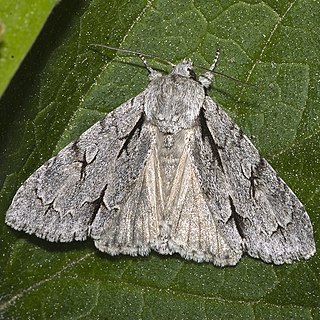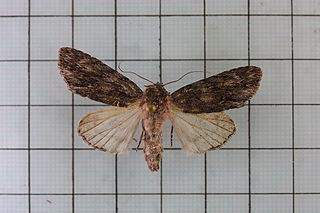
The miller is a moth of the family Noctuidae. It is found throughout Europe apart from the far south-east. The range extends from the South of Spain, Central Italy and Bulgaria to Scotland and Central Scandinavia, crossing the Arctic Circle in Finland and Norway. Outside Europe it is only known in North Africa. In the Eastern Palearctic and the Nearctic realm it is replaced by Acronicta vulpina, formerly known as Acronicta leporina subspecies vulpina.

Acronicta is a genus of noctuid moths containing about 150 species distributed mainly in the temperate Holarctic, with some in adjacent subtropical regions. The genus was erected by Carl Linnaeus in his 1758 10th edition of Systema Naturae. Caterpillars of most Acronicta species are unmistakable, with brightly colored hairy spikes, and often feed quite visibly on common foliate trees. The hairy spikes may contain poison, which cause itchy, painful, swollen rash in humans on contact. The larva of the smeared dagger moth is unusually hairy even for this genus. Acronicta species are generally known as dagger moths, as most have one or more black dagger-shaped markings on their forewing uppersides. But some species have a conspicuous dark ring marking instead.

John Henry Leech was an English entomologist who specialised in Lepidoptera and Coleoptera.

Acronicta rumicis, the knot grass moth, is a species of moth which is part of the genus Acronicta and family Noctuidae. It was first described by Carl Linnaeus in his 1758 10th edition of Systema Naturae. It is found in the Palearctic region. A. rumicis lives and feeds on plants located in wide-open areas. At its larval stage, as a caterpillar, it causes such a large impact as a crop pest that it has received much attention and research. A. rumicis feeds on maize, strawberries and other herbaceous plants.

Acronicta lanceolaria, the lanceolate dagger moth or pointed dagger, is a moth of the family Noctuidae. The species was first described by Augustus Radcliffe Grote in 1875. It is found in North America, from Nova Scotia to British Columbia. It is listed as a species of special concern and believed extirpated in the US state of Connecticut.

Antivaleria is a genus of moths of the family Noctuidae. The genus was erected by Shigero Sugi in 1958.

Cidariplura is a genus of moths of the family Erebidae. The genus was erected by Arthur Gardiner Butler in 1879.

Condica is a genus of moths of the family Noctuidae. The genus was erected by Francis Walker in 1856.
Mecodina is a genus of moths of the family Erebidae first described by Achille Guenée in 1852.

Acronicta impressa, the impressive dagger moth or willow dagger moth, is a moth of the family Noctuidae. The species was first described by Francis Walker in 1856. It is found from western Canada to north-western Mexico.
Acronicta vulpina, the vulpina dagger moth or miller dagger moth, is a moth of the family Noctuidae. The species was first described by Augustus Radcliffe Grote in 1883. It is found in North America from New York and Newfoundland west to central British Columbia, south to Colorado.

Acronicta albistigma is a moth of the family Noctuidae. It is found in China, Japan, and Taiwan.

Acronicta carbonaria is a moth of the family Noctuidae. It is found in Japan, the Korean Peninsula, and the Russian Far East.
Acronicta bellula is a moth of the family Noctuidae. It is found in the Korean Peninsula, the Russian Far East, and China.
Acronicta adaucta is a moth of the family Noctuidae first described by William Warren in 1909. It is found in the Korean Peninsula, Japan, north-eastern China and the Russian Far East.

Acronicta hercules is a moth of the family Noctuidae. It is found in the Korean Peninsula, Japan, the Russian Far East, China, and Taiwan.

Acronicta digna is a moth of the family Noctuidae. It is found in the Korean Peninsula, Japan, the Russian Far East, China, and Taiwan.
Acronicta valliscola is a moth of the family Noctuidae, originally described by André Blanchard in 1968. It is found only in Big Bend National Park in Texas, United States.

Acronicta insita, the large gray dagger or fingered dagger, is a moth of the family Noctuidae. The species was first described by Augustus Radcliffe Grote in 1874. It is found from Newfoundland west to the Pacific coast and Vancouver Island and Haida Gwaii, British Columbia, south to North Carolina and Colorado.
Epipsestis ornata is a moth in the family Drepanidae. It was described by John Henry Leech in 1889. It is found in Japan, the Korean Peninsula, the Russian Far East and the Chinese provinces of Heilongjiang, Jilin and Shaanxi.








